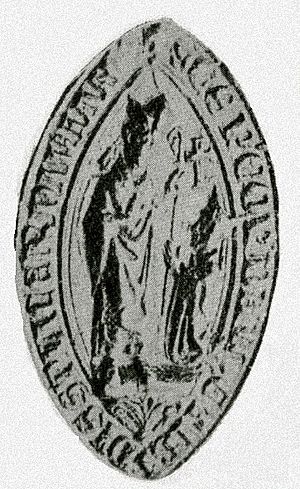Henry of Holyrood facts for kids
Quick facts for kids Henry of Holyrood |
|
|---|---|
| Bishop of Galloway | |

Bishop Henry's seal
|
|
| Church | Roman Catholic Church |
| See | Diocese of Galloway |
| In Office | 1253–1293 |
| Predecessor | Gilbert |
| Successor | Thomas de Dalton |
| Orders | |
| Consecration | 1255 or 1256 |
| Personal details | |
| Born | unknown unknown |
| Died | 1 November 1293 |
| Previous post | Abbot of Holyrood |
Henry was an important church leader in the 1200s. He was an Augustinian abbot and later a bishop. He is best known for being the Abbot of Holyrood and the Bishop of Galloway. He died in 1293.
Contents
Becoming a Bishop
We don't know exactly when Henry became an Augustinian monk. We also don't know when he became the Abbot of Holyrood Abbey. The last abbot before him was Elias, mentioned in 1236.
In 1253, a historical record called the Chronicle of Melrose states that Henry, the Abbot of Holyrood, was chosen. He was to become the new Bishop of Whithorn. Whithorn is also known as Galloway.
Election Challenges
The exact date of his election is not fully clear. In October 1254, a document from Dunfermline Abbey still called him "Abbot." It did not call him "bishop-elect."
Henry's election was supported by the Comyn family. This family was very powerful in Scotland at the time. They had a lot of influence over the young King Alexander III of Scotland.
However, John I de Balliol at first disagreed with Henry's election. Balliol said it went against the "ancient liberty of his subjects." This meant the rights of the people of Galloway. Even though Balliol was usually an ally of the Comyn family, he wanted to protect his own rights. In the end, Balliol's objections did not stop Henry's election.
Consecration Delay
An official review of the election happened in York on February 11, 1255. The Archbishop of York confirmed the election on February 24. However, there was a delay before Henry became a bishop. This process is called consecration.
The Melrose Chronicle says Henry's consecration happened after Gamelin became Bishop of St Andrews. That event took place on December 25, 1255.
Historical records give different details about Henry's consecration. The Melrose Chronicle says Walter de Gray performed it. But Walter de Gray died in May 1255. The Lanercost Chronicle says Walter of Kirkham, the Bishop of Durham, performed it. This happened on February 7, 1255, near Richmond. Historian D. E. R. Watt believes the consecration might have actually taken place in early 1256.
Later Life and Work
Henry was a witness to the founding document of Sweetheart Abbey in April 1273. In 1287, the Archbishop of York allowed Bishop Henry to skip his yearly visit to York. This was because of his old age.
Despite his age, Bishop Henry was still active. He visited Ireland on August 4, 1291. He was also at Birgham on March 17, 1290. There, he helped negotiate the Treaty of Birgham. This treaty was important for Scotland's future.
In 1292, Henry was chosen by John de Balliol to represent him. This was during a major event called the Great Cause. This event decided who would be the next King of Scotland.
Henry died on November 1, 1293. The Lanercost Chronicle described him as "a man discreet, holy, and provident for his house and his parish." This means he was wise, religious, and cared for his church and community.
Discovery of His Remains
Between 1957 and 1967, archaeologists excavated Whithorn Priory. They found the remains of several important church leaders. At the time, their identities were unknown.
In 2007, research funded by Historic Scotland helped identify six bishops from these remains. Henry was one of them. The research showed that these church leaders ate good quality meat and fish. They likely came from southern Scotland or Cumbria.
Henry's grave contained special items. These included "very fine gilded altar vessels," a gold ring, and parts of a wooden crozier. A crozier is a staff carried by bishops. Analysis of his remains also showed that Henry helped rebuild parts of the priory. It had been damaged by soldiers in 1286. The research also revealed that Henry had suffered from tooth problems.

